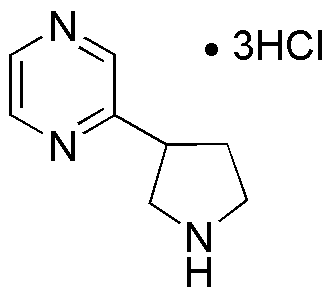2-Pyrrolidin-3-yl-pyrazine dihydrochloride is widely utilized in research focused on:
- Pharmaceutical Development: This compound serves as a key intermediate in the synthesis of various pharmaceuticals, particularly in the development of drugs targeting neurological disorders.
- Neuroscience Research: It is employed in studies investigating neurotransmitter systems, helping researchers understand brain functions and potential treatments for mental health conditions.
- Agrochemical Formulations: The compound is used in the formulation of agrochemicals, enhancing the efficacy of pesticides and herbicides, which is crucial for improving crop yields.
- Material Science: It finds applications in creating novel materials with specific properties, such as improved thermal stability and electrical conductivity, beneficial for electronics and coatings.
- Analytical Chemistry: The compound is utilized as a standard in various analytical techniques, aiding in the accurate quantification of related substances in complex mixtures.
General Information
Properties
Safety and Regulations
Applications
2-Pyrrolidin-3-yl-pyrazine dihydrochloride is widely utilized in research focused on:
- Pharmaceutical Development: This compound serves as a key intermediate in the synthesis of various pharmaceuticals, particularly in the development of drugs targeting neurological disorders.
- Neuroscience Research: It is employed in studies investigating neurotransmitter systems, helping researchers understand brain functions and potential treatments for mental health conditions.
- Agrochemical Formulations: The compound is used in the formulation of agrochemicals, enhancing the efficacy of pesticides and herbicides, which is crucial for improving crop yields.
- Material Science: It finds applications in creating novel materials with specific properties, such as improved thermal stability and electrical conductivity, beneficial for electronics and coatings.
- Analytical Chemistry: The compound is utilized as a standard in various analytical techniques, aiding in the accurate quantification of related substances in complex mixtures.
Documents
Safety Data Sheets (SDS)
The SDS provides comprehensive safety information on handling, storage, and disposal of the product.
Product Specification (PS)
The PS provides a comprehensive breakdown of the product’s properties, including chemical composition, physical state, purity, and storage requirements. It also details acceptable quality ranges and the product's intended applications.
Certificates of Analysis (COA)
Search for Certificates of Analysis (COA) by entering the products Lot Number. Lot and Batch Numbers can be found on a product’s label following the words ‘Lot’ or ‘Batch’.
Numéro de catalogue
Numéro de lot/série
Certificates Of Origin (COO)
This COO confirms the country where the product was manufactured, and also details the materials and components used in it and whether it is derived from natural, synthetic, or other specific sources. This certificate may be required for customs, trade, and regulatory compliance.
Numéro de catalogue
Numéro de lot/série
Safety Data Sheets (SDS)
The SDS provides comprehensive safety information on handling, storage, and disposal of the product.
DownloadProduct Specification (PS)
The PS provides a comprehensive breakdown of the product’s properties, including chemical composition, physical state, purity, and storage requirements. It also details acceptable quality ranges and the product's intended applications.
DownloadCertificates of Analysis (COA)
Search for Certificates of Analysis (COA) by entering the products Lot Number. Lot and Batch Numbers can be found on a product’s label following the words ‘Lot’ or ‘Batch’.
Numéro de catalogue
Numéro de lot/série
Certificates Of Origin (COO)
This COO confirms the country where the product was manufactured, and also details the materials and components used in it and whether it is derived from natural, synthetic, or other specific sources. This certificate may be required for customs, trade, and regulatory compliance.


